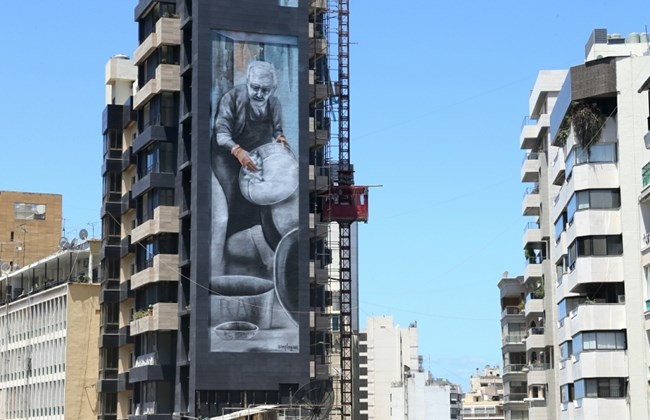Latest news

Ras Beirut artisan inspires mural in Hamra
Alexander Durie | The Daily Star
BEIRUT: Anyone stumbling onto the crossroads of Tannoukhiyeen and Kuwait Streets, known by many Ras Beirut residents as “Abu Taleb” (after a shop that used to occupy a nearby corner), will find a new mural.
Painted on the side of a structure still under construction, the work depicts an old man plying an antique trade. Abdul-Razak Shehab, on whose image the mural is based, passed away in 2014 at the age of 85. It’s said he was Ras Beirut’s last “mobayed” - a person who practices the artisanal craft of polishing copper pans.
Standing 41 meters high, the mural is the latest addition to NGO Ahla Fawda’s Art of Change project, whose stated goal is to empower communities through urban art. This is the NGO’s fifth Beirut mural, the most recent having been unveiled in Hamra last May.
The new mural was produced to honor Beirut’s rapidly dwindling local communities and long-standing families, who have so often been displaced by urban development and gentrification, while paying tribute to a now obsolete profession.
Ahla Fawda commissioned the work from Greek-born street artist Simple G, who has installed an array of public art pieces across Europe. The artist had never been in Lebanon before being invited to paint this mural, his tallest yet, which he completed in three days.
“I wanted to paint the work, not the worker,” Simple G informed The Daily Star. He said the family asked him to render the elder Shehab’s face so that the figure resembles any old man. While the work depicts Shehab, then, it can be seen to represent any Beirut laborer working his craft in his family neighborhood. The artist applied color only to the figure’s gloves, to emphasize the manual craftsmanship of his labor.
The mural’s evocation of neighborhood history adorns a building that’s been under construction for the past three years and the developer, RAWA Engineering, paid for the work. Yasser Noureddine, RAWA’s chairman, says he’s on personal terms with the Shehab family and wanted to pay homage to Abdul-Razak Shehab. “These days, most people sell their land and leave Beirut to go live outside town, but this family refused and wanted to stay on its grandfather’s land,” Noureddine said. “I wanted to honor Shehab’s work, but also the ordinary people of this neighborhood.”
Other members of the Shehab family, who for generations lived in a building facing the site, will, Noureddine said, be moved into the structure bearing Abdul-Razak’s mural. “Each family will have a new apartment in this building,” Noureddine promised.
A version of this article appeared in the print edition of The Daily Star on July 17, 2019, on page 12
